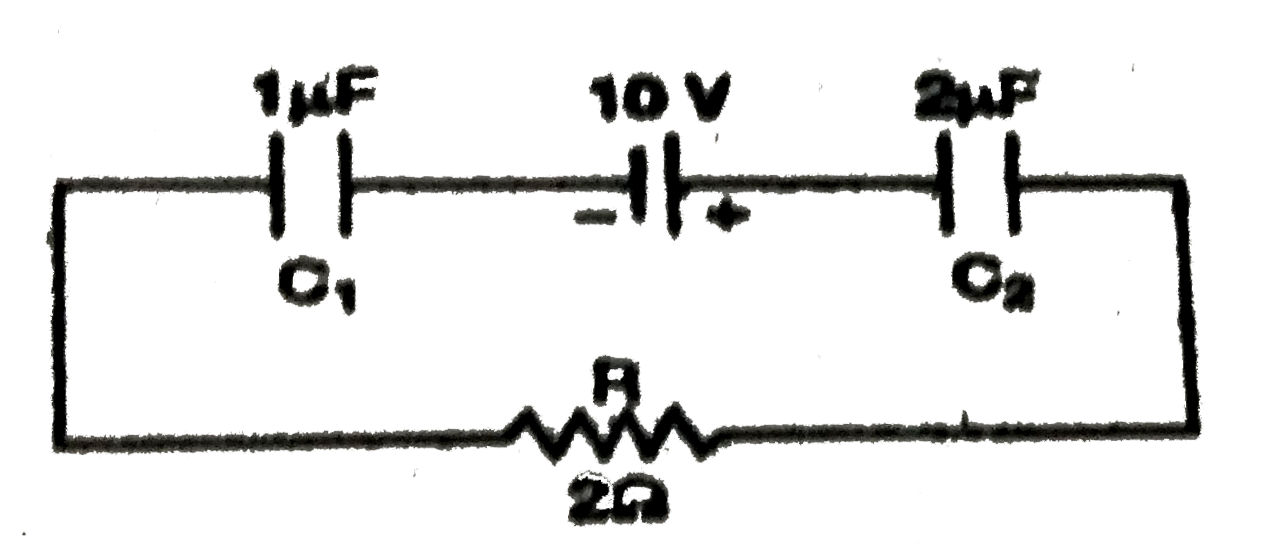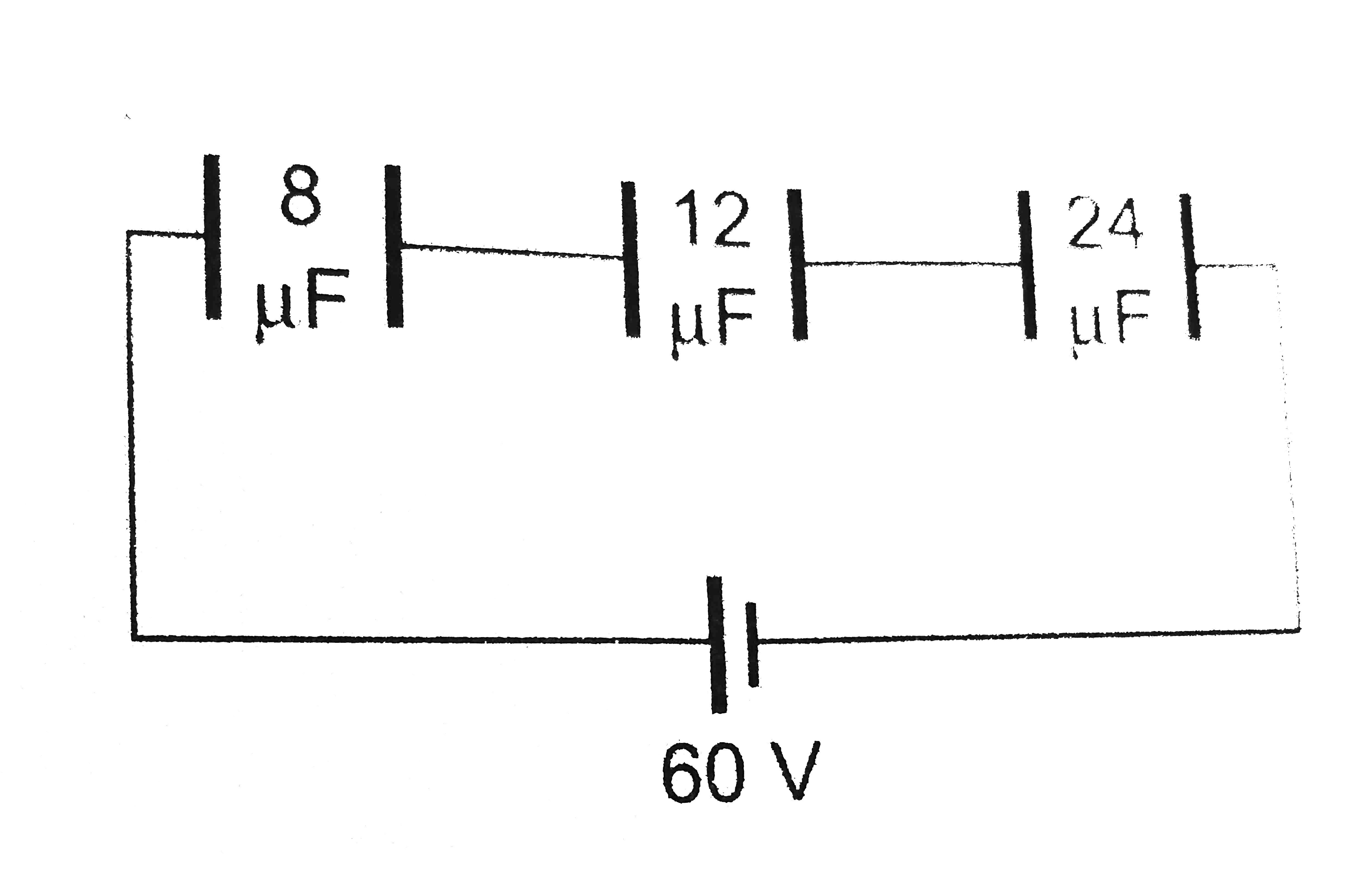Assertion : In series combination, charges on two capacitors are always equal.
Reason : If charges are same, the total potential difference applied across two capacitors will be distributed in inverse ratio of capacities.
If both Assertion and Reason are true and the Reason is correct explanation of the Assertion.
If both Assertion and Reason are true but Reason is not the correct explanation of Assertion.
If Assertion is true, but the Reason is false.
If Assertion is false but the Reason is true.
The correct Answer is:D
To solve the question, we need to analyze both the assertion and the reason provided.
Step 1: Understand the Assertion
The assertion states: "In series combination, charges on two capacitors are always equal."
- When capacitors are connected in series, the same amount of charge (Q) flows through each capacitor. This is because the charge that leaves one capacitor must enter the next, leading to the conclusion that the charge on each capacitor in a series configuration is the same.
Step 2: Understand the Reason
The reason states: "If charges are the same, the total potential difference applied across two capacitors will be distributed in inverse ratio of capacities."
- The potential difference (V) across a capacitor is given by the formula V=QC, where Q is the charge and C is the capacitance.
- In a series combination, the total potential difference (V_total) across the capacitors is the sum of the individual potential differences across each capacitor:
Vtotal=V1+V2=QC1+QC2
- Since the charge Q is the same on both capacitors, the potential difference across each capacitor will indeed be inversely proportional to their capacitances. This means that if one capacitor has a larger capacitance, it will have a smaller voltage across it compared to a capacitor with a smaller capacitance.
Step 3: Conclusion
Both the assertion and the reason are true:
- The assertion is true because charges on capacitors in series are equal.
- The reason is also true because the potential difference is distributed in inverse ratio of the capacitances.
However, the reason does not directly explain the assertion, as it focuses on the relationship between charge and potential difference rather than directly addressing why the charges are equal in series.
Final Answer
Both the assertion and reason are true, but the reason is not the correct explanation of the assertion. Therefore, the correct option is:
Option B: Both assertion and reason are true, but reason is not the correct explanation of assertion.
The assertion states: "In series combination, charges on two capacitors are always equal."
The reason states: "If charges are the same, the total potential difference applied across two capacitors will be distributed in inverse ratio of capacities."
- In a series combination, the total potential difference (V_total) across the capacitors is the sum of the individual potential differences across each capacitor:
Vtotal=V1+V2=QC1+QC2
- Since the charge Q is the same on both capacitors, the potential difference across each capacitor will indeed be inversely proportional to their capacitances. This means that if one capacitor has a larger capacitance, it will have a smaller voltage across it compared to a capacitor with a smaller capacitance.
Both the assertion and the reason are true:
- The assertion is true because charges on capacitors in series are equal.
- The reason is also true because the potential difference is distributed in inverse ratio of the capacitances.
Both the assertion and reason are true, but the reason is not the correct explanation of the assertion. Therefore, the correct option is:
Option B: Both assertion and reason are true, but reason is not the correct explanation of assertion.
Topper's Solved these Questions
- BOOK - DC PANDEY ENGLISHCHAPTER - CAPACITORSEXERCISE - OBJECTIVE_TYPE1videos
CAPACITORS
- BOOK - DC PANDEY ENGLISHCHAPTER - CAPACITORSEXERCISE - OBJECTIVE_TYPE1videos
CAPACITORS
- BOOK - DC PANDEY ENGLISHCHAPTER - ATOMSEXERCISE - MEDICAL ENTRANCES GALLERY42videos
ATOMS
- BOOK - DC PANDEY ENGLISHCHAPTER - COMMUNICATION SYSTEMEXERCISE - Subjective11videos
COMMUNICATION SYSTEM
Similar Questions
Knowledge Check
- Question 1 - Select One
Assertion- In a series combination of capacitors, charge on each capacitor is same.
Reason- In such a combination, charge cannot move only along one route.AIf both assertion and reason are ture and reason is the correct explanation of assertion.BIf both assertin and reason are ture but reason is not the correct explanation of assertion .CIf assertion is true but reason is false.DIf both assertion and reason are false.
A 10V battery is connected to two capacitors C1 and C2 and a resistor R. When the capacitors are fully charged, then the potential difference across the resistor will be
 View Solution
View SolutionThe 500μF capacitor is charged at a steady rate of 100μC/s. The potential difference across the capacitor will be 10 V after an interval of
View SolutionThe 500μF capacitor is charged at a steady rate of 100μC/s. The potential difference across the capacitor will be 10 V after an interval of
View SolutionA capacitor is charged steadily from a DC source. Correct variation of potential difference across the plates of capacitor with charge on the plates of capacitor is
View SolutionA series combination of three capacitors of capacities 1μF,2μF and 8μF is connected to a battery of e.m.f. 13 volt .The potential difference across the plates of 2μF capacitor will be
View SolutionIn the given circuit, with steady current, calculate the potential difference across the capacitor and the charge stored in it.
View SolutionIf A is connerted with D and B is connected with C find the potential difference a across each capacitor and the final charge in each capacitor.
View Solution



